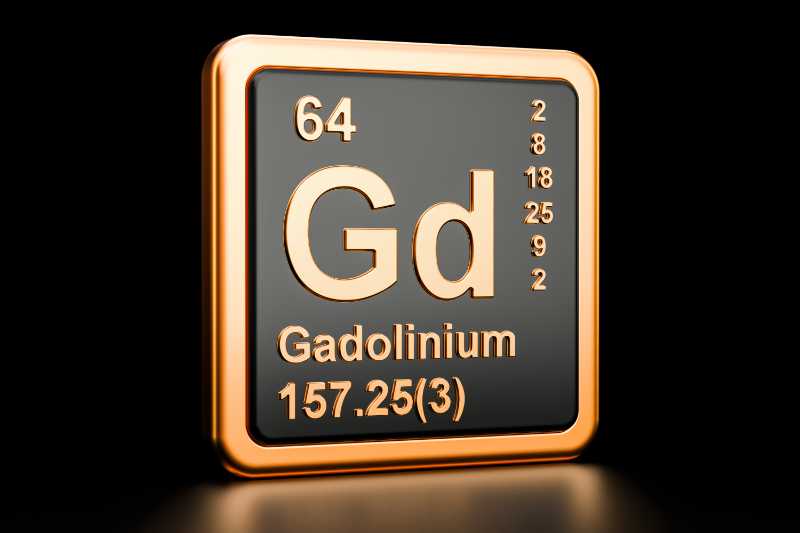Gadolinium
Poisoning
When patients get an MRI, they are often injected with a substance to enhance its contrast and clarity. This substance is called gadolinium, which is a naturally-occurring chemical element. The problem is that gadolinium does not always leave the body once it enters. If Gado is retained, it can cause severe side effects. In a worst-case scenario, complications of gadolinium poisoning impact kidney function and can cause death. Gadolinium is infamous for causing the following:
- Gadolinium toxicity,
- Gadolinium deposition disease,
- Nephrogenic Systemic Fibrosis.
We are no longer reviewing these lawsuits.
Because of these (often undisclosed) risks, attorneys have filed multiple gadolinium toxicity lawsuits against the manufacturers of this kind of MRI contrast dye. If you think you’re among those who have been affected, contact Defect Lawyers today to see if you qualify for a gadolinium lawsuit.

About Gadolinium lawsuits
Gadolinium lawsuits – also known as MRI dye lawsuits, MRI with contrast lawsuits, and gadolinium toxicity lawsuits – are relatively new. There are many Gadolinium lawsuits that are still pending. Notwithstanding the lack of settlements and judgments, new MRI dye lawsuits are being filed. Many victims are searching desperately for info about: “MRI dye lawsuit” ,”gadolinium mri”, “gadolinium contrast”, “gadolinium poisoning” and “Info. about chuck Norris wife diagnosis.” Gadolinium poisoning is a very serious matter and you should contact a gadolinium poisoning lawsuit lawyer.
Update- November 2023- “A physician’s group in Iowa has agreed to pay $2 million to resolve a wrongful death lawsuit brought by the family of a woman who died after receiving a gadolinium MRI contrast dye injection. The original complaint was filed in late 2018, indicating that Katherine Decker suffered an anaphylactic reaction after she was injected with Gadovist, a Bayer HealthCare gadolinium-based contrast dye used to enhance magnetic resonance imaging (MRI) results. She suffered immediate brain injuries, and was pronounced dead less than an hour after her diagnosis.” about lawsuits
1/17/2020- “Actor Chuck Norris and his wife, Gena, have decided to vacate their lawsuit against gadolinium maker Bracco Imaging without any settlement, the company announced Jan. 16. The action star—famous for his portrayal of “Walker Texas Ranger”—first filed suit against the Italy-based company and several other manufacturers in 2017. His attorneys claimed that the controversial contrast agent poisoned Gena Norris during MRI scans, and had sought $10 million to allay those concerns. However, Bracco said the dispute is over at Norris’ request, with no settlement and each side agreeing to cover its own legal expenses.” Radiology
8-27-2020- “A Blair County jury has awarded $10.8 million to a man who sustained a brain injury after suffering an allergic reaction to a substance administered to him in a hospital. The verdict was awarded to plaintiff Christopher Miller, who sued Tyrone Hospital for negligence and medical malpractice for allegedly failing to appropriately respond to his allergic reaction to a contrast medium, a liquid given to patients undergoing radiological imaging to make results clearer. This was a completely preventable tragedy, which the jury acknowledged with its verdict,” said the plaintiff’s lawyer, Brendan Lupetin of Meyers Evans Lupetin & Unatin. “The Blair County court system, Judge Jackie Bernard and the jurors deserve the highest accolades for doing everything necessary to allow this important case to go forward in spite of the COVID pandemic. This trial and the verdict prove that jury trials can safely resume. The verdict also proves that if doctors or hospitals are negligent and hurt patients, they won’t get a pass just because of the pandemic. Juries will do their job and uphold justice no matter what… According to the plaintiff’s pretrial memorandum, Miller went to the hospital for an MRI of his back. After Miller ingested gadolinium, MRI technician Sherry Piper observed Miller had trouble breathing. Piper allegedly left the room to alert a doctor about Miller’s condition.” Law
6-6-2020- “The trio of experts, which includes two doctors and a lawyer, believe recent court rulings and evidence disputing GDD’s existence will make law firms “less likely” to represent patients claiming to suffer from the “disease.” They recommend radiologists follow imaging society guidance and take a patient-focused approach to administering GBCAs to mitigate what liability risk they may face, according to their comments published Friday in JACR. If experience has taught us anything, it is that the best legal defense always seems to rest on successfully demonstrating that, contemporaneously, you had the patient’s, not your own, best interests as the primary motivating factor for the patient care decisions you made,” wrote Emanuel Kanal, MD, with the University of Pittsburgh Medical Center’s Department of Radiology, and colleagues.” health imaging
What is Gadolinium and Why is it Used in MRIs?
Gadolinium is an element with the atomic number of 64 and is a rare-earth metal. The element has many different uses including in microwave applications and in color television tubes. Its variety of uses is due to its metallic properties.
With regard to MRIs, gadolinium acts as a dye. When a patient receives an MRI with contrast, gadolinium is injected into the body. The same properties that make it effective in color televisions act to improve and enhance the MRI pictures for the doctor’s viewing. Doctors will not inject pure gadolinium into a patient’s body. Instead, the gadolinium will be mixed with other substances. One of these additives is an agent that is intended to counteract the toxicity of gadolinium since the pure substance could never be injected directly into a patient’s body. If you are seeking an MRI dye lawsuit, contact us at the number on this website.
Gadolinium side effects
In rough order of frequency as reported in our Survey of the Chronic Effects of Retained Gadolinium from Contrast MRIs, Pain – aching; burning, tingling, and/or prickling pain (paresthesia); deep bone pain. Typically in extremities or joints, and sometimes in the location where the MRI occurred, like the head.”
https://gadoliniumtoxicity.com/help/symptoms/
- Dermal changes – like tight skin, lesions, hyperpigmentation. Most often in extremities.
- Muscle issues – twitching – small, local, rapid contractions and weakness
- Ocular problems – worsening vision, dry eyes, bloodshot eyes
- Cognitive symptoms
- Ear, nose and throat – tinnitus, swallowing, and voice problems
- Low body temperature
- Hair loss
- Itchy skin
- Balance problems
- Swelling of extremities (edema)
There is one symptom experienced by many that transcends several of the symptoms listed above. It is a sense of an electrified, vibrating, twitching feeling typically just under the skin that is sometimes localized and at other times a more overall feeling. Sometimes it feels like something is crawling around under the skin. This is a particularly alarming feeling when first experienced as it is unlike anything that the person has ever experienced and it is very difficult to explain to doctors
Chuck Norris Lawsuit
Chuck Norris claims his wife was poisoned during MRI scans, sues for $10 million
“Actor and martial artist Chuck Norris is suing several health-care companies, claiming his wife was poisoned by a chemical used during magnetic resonance imaging scans. In a lawsuit filed last week in San Francisco Superior Court, Chuck and Gena Norris argued that gadolinium, a metal used as a contrast agent in MRI scans, caused Gena to sustain gadolinium deposition disease, experiencing “multiple, debilitating bouts of pain and burning throughout her body” and suffering long-term damage. The Norrises are seeking more than $10 million in damages from companies they say should have warned them of risks.”
“Over the past several years, my focus has been on Gena’s health,” Chuck Norris said in a statement Tuesday to The Washington Post. “And now we are working together to speak out about the dangers of MRI contrast agents.” Chuck Norris wife- Washington Post article
How it works
PROVING
Product LIability

1
Determining Eligibility
- More than one MRI since 2010
- At least one of the following Gadolinium complications: “Significant arm/ leg pain, Persistent Bone/ Joint Pain, Chronic Headache, Tissue Burning Sensation, pins and needles, Brain Fog, Nauseau / omiting, Thickening/ Darkening of the Skin, Shortening of muscles/ tendons, Gadolinium Storage Condition diagnosis, Gadolinium Deposition Disease Diagnosis, Nephrogenic Systemic Fibroses Diagnosis.” (Quote from Consumer Awareness Group, Full service marketing and intake support center)
Even if you do not meet the above qualifications for a Gadolinium lawsuit, you should contact a Gadolinium lawsuit law firm to see whether you can still file an MRI with Gado lawsuit.
Liability Theory #1: Failure to Disclose
The manufacturers of gadolinium are alleged to have knows about the issue with retention since shortly after the substance was approved for use in MRIs. Their knowledge of this potential condition dates as far back to 1998. While much of the focus on gadolinium retention focused on people who already had kidney conditions, the manufactures allegedly knew of other issues with the substance that would cause retention. According to the complaints, the knowledge about gadolinium retention further increased this decade to the point where manufacturers definitely should have known there was an issue. Nevertheless, the substance was continuing to be sold without any product warnings concerning mri contrast. Many people are desperately searching the internet for info about gadolinium MRI.
2
3
Liability Theory #2: Negligent Design & Manufacturing
In addition to the failure to warn, the gadolinium lawsuits have generally alleged that gadolinium makers have been negligent in their design and manufacture of the product. These manufacturers have the obligation to design a safe product that is free from defects. Instead, they have designed and sold a product that is retained in the bodies of some patients and has caused long-term health problems. Reasonable care and testing could have detected such problems. In addition, some of these lawsuits have accused the manufacturers of fraud and misrepresentation when they claimed that gadolinium-based agents were safe for use in MRIs. The manufacturers are alleged to have actively concealed information that this substance could be harmful. Since the first cases were filed in 2016, none of these lawsuits have yet proceeded to trial and have received a decision on the merits. Whether you want to file a gadolinium lawsuit as a result of gadolinium poisoning is a difficult decision.
gadolinium poisoning
Gadolinium is used in about 30 percent of MRIs. It is used when the scan needs to diagnose some sort of inflammation or tumor. It is administered intravenously either before or during an MRI with contrast. The compound is supposed to only temporarily be in the patient’s body. The intention is that the gadolinium is passed out of the body through the patient’s urine within a day of receiving the injection. MRI contrast side effects are not to be taken lightly. A mri medical abbreviation is well known in the general public and many people are filing mri lawsuits. An MRI lawsuit is a way for victims to receive justice and compensation as a result of Gadolinium poisoning
Side Effects of Gadolinium
When any naturally occurring element is injected directly into the patient’s body, there is a possibility of an adverse reaction. While the gadolinium is only supposed to remain inside the patient for only a day, that does not always happen. This is the major side effect of gadolinium. The immediate reaction to an injection is most often minimal, although subsequent reactions are usually more severe than the first. In addition, gadolinium can have a severe impact on a patient who is already suffering in any way from reduced kidney function. In those instances, patients can contract nephrogenic systemic fibrosis which can lead to death.
Gadolinium complications
The real danger that is commonly posed to those receiving gadolinium occurs is that the substance is retained in the body. When the body fails to expel all of the gadolinium, it is holding onto a toxic substance that can interfere with normal body function. This results in Gadolinium Deposition Disease which is both painful and incurable. In a worst-case scenario, gadolinium can remain in the patient’s body for years. While the symptoms are not necessarily fatal, they can degrade the patient’s quality of life. The symptoms can include joint pain, fatigue, memory loss and general confusion. Other symptoms include a burning sensation and heart palpitations. These health issues can become debilitating and ongoing.
FDA Warning | MRI dye lawsuit
The FDA had long been concerned about gadolinium elimination, but the early concern was for patients with known problems eliminating drugs. Recently, that concern has been expanded. In December 2017, the FDA issued a safety announcement regarding gadolinium. The FDA’s announcement was issued after undertaking a review. After review and consultation, the FDA required several actions pertaining to gadolinium. Now, patients must receive additional education about the substance before they can agree to receive it as part of the MRI. This includes receiving a Medication Guide that details information about possible side effects. In addition, the FDA directed the manufacturers of gadolinium to conduct a new series of tests on both humans and animals. In Europe, some of these products can no longer be used after a decision from the European Medicines Agency.
Gadolinium-Related Diseases
“On May 18, 2018, Dr. Richard Semelka added Head Pain to the recently revised primary clinical diagnostic findings for Gadolinium Deposition Disease (GDD) and he described two critical diagnostic features of GDD. First, symptoms of Gadolinium deposition disease must start within minutes to one month after administration of a gadolinium-based contrast agent (GBCA). Second, the symptoms experienced by the patient after GBCA administration must be new, and not preexisting.
There are now 6 symptoms that stand out to Dr. Semelka as critical diagnostic findings for GDD. He said that it is imperative that individuals have at least 3 of the symptoms, but he prefers to see 5/6 to be certain of the diagnosis.”

GDD symptoms Include:
“1. Intense burning of the skin and skin substrate. Arising in early stage (early on after GBCA): This can be an all over feeling in the body, but often may be localized to the trunk region or distal extremities.
2. Intense boring pain in bones or joints. Arising in early stage (early on after GBCA): This can be any bones or any joints. Often the joints may be peripheral but can also be large joints like the knee or hip. Any bones can have severe point pain, but rib pain is quite distinctive for the disease.
3. Brain fog. Arising in early stage (early on after GBCA): Many terms have been used for this: mental confusion sounds more scientific, but brain fog gets the point across well and succinctly. Brain fog is also a prominent feature of lead toxicity, which is another heavy metal toxicity.
4. Muscle vibrations (muscle fasciculations) and skin pins and needles/tingling (early on after GBCA). These symptoms may represent part of the same process that is causing brain fog. Muscle vibrations /twitching and pins and needles skin sensations generally reflect nerve disease (neuropathy).
5. Head pain (early on after GBCA). Headache is both a very common occurrence and shows tremendous variability. GDD sufferers describe it as a head pain, and unlike any other type of head-ache they have previously experienced. These two properties provide differentiating features for this entity. Some describe it as a burning pain and as an extreme tightness feeling (like a tight bathing cap on their head).
6. Distal arm and leg skin/skin substrate thickening, discoloration, and pain. Arising in the subacute stage (2 weeks +): This is very much like the principal features of NSF, but generally less severe. Instead of woodiness, doughiness; instead of redness, pinkness; instead of extreme joint contractures, stiffness of joints and decreased range of motion. Skin tightness is a feature of GDD as well. This symptom complex should be expected.”
https://gadoliniumtoxicity.com/tag/gadolinium-deposition-disease/

Similar Conditions:
What can happen when Gadolinium remains in the body?
“Several conditions can occur as a result of gadolinium retention:
- Nephrogenic systemic fibrosis (NSF)
- Gadolinium storage condition
- Gadolinium deposition disease”
NSF occurs in patients with renal insufficiency. In these patients, gadolinium cannot be removed from the body adequately as a result of decreased kidney function. As a result, thickening and darkening of the skin, shortening of the muscles and tendons, and other symptoms can occur. This condition can potentially be fatal.
Gadolinium storage condition
Gadolinium storage condition is the excess of gadolinium in patients with normal renal function. ” Id.
“Gadolinium deposition disease occurs when a patient has an excess of gadolinium in their system, but they have normal or adequate renal function. Symptoms of this condition can manifest anywhere from a few hours to several weeks after the GBCA injection was administered, and are as follows:
- Persistent headache
- Severe pain in the bones, joints, arms, and legs
- Sensation of sharp pins and needles, cutting, or burning
- Cognitive impairment
- Clouded mentation (“brain fog”)
- Nausea / vomiting
- Thickening of soft-tissue, tendons, and ligaments
- Tightness in the hands and feet”” Id.
